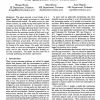Free Online Productivity Tools
i2Speak
i2Symbol
i2OCR
iTex2Img
iWeb2Print
iWeb2Shot
i2Type
iPdf2Split
iPdf2Merge
i2Bopomofo
i2Arabic
i2Style
i2Image
i2PDF
iLatex2Rtf
Sci2ools
ICRA
1999
IEEE
1999
IEEE
Design of a Spider-Like Robot for Motion with Quasistatic Force Constraints
Abstract: This paper presents a novel design of a Jiegged "spider" robot capable of moving in a wide range of two-dimensional tunnels. The spider moves in a quasistatic manner, by stably bracing itself against the tunnel walls and moving a free limb to a new position. The design has been strongly influenced by the recent immobilization theory of Rimon and Burdick [13, 15]. The theory dictates the minimum number of limbs such a spider can have, as well as the shape of the footpads. The class of tunnel geometries dictates other key parameters of the spider, such as limb dimensions and number of degrees of jieedom of each limb. We review the relevant components of the immobilization theoy, then describe the details of the spider design. The spider will initially move under a worst-case assumption of slippey tunnel walls, and we also descn"be a locomotion strategy under this assumption. The spider has been built and is currently undergoing locomotion experiments.
ICRA 1999 | Robotics | Spider | The Spider | Tunnel Walls |
| Added | 03 Aug 2010 |
| Updated | 03 Aug 2010 |
| Type | Conference |
| Year | 1999 |
| Where | ICRA |
| Authors | Shraga Shoval, Elon Rimon, Amir Shapiro |
Comments (0)

